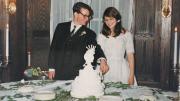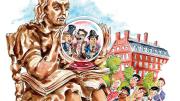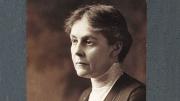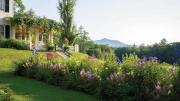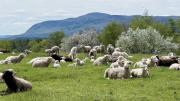 |
"Your wooden arm you hold outstretched to shake with passers-by." |
Five pieces of lead type turned up near Matthews Hall this year, a stop-the-presses flash from the past. They were unearthed by students and faculty of Anthropology 1130: “Archaeology of Harvard Yard.”
In 1655, with seed money from the Society for the Propagation of the Gospel in New England, Harvard built a two-story brick edifice in the Yard called Indian College, on the site of today’s Matthews Hall, and promised to house American Indian students and teach them Greek, Hebrew, and Protestantism tuition free. Few Indians appeared. (Only one took a degree, Caleb Cheeshahteaumuck, an Aquinnah Wampanoag, of the class of 1665.) The College began to quarter regular students in the building, which by 1698 had fallen into disrepair. Harvard tore it down and reused the bricks.
 Despite the lack of native students, much good propagating went on in Indian College. It was there that Harvard kept its printing press, the first in North America, with which missionary John Eliot produced his widely deployed translation of the Bible into Algonquin. Professor William L. Fash, leader of the Yard dig and Howells director of the Peabody Museum of Archaeology and Ethnology, believes the type shown was used by James Printer, the Nipmuc Indian apprentice who manned the press, to produce the Bible and other godly works in the Indians’ language.
Despite the lack of native students, much good propagating went on in Indian College. It was there that Harvard kept its printing press, the first in North America, with which missionary John Eliot produced his widely deployed translation of the Bible into Algonquin. Professor William L. Fash, leader of the Yard dig and Howells director of the Peabody Museum of Archaeology and Ethnology, believes the type shown was used by James Printer, the Nipmuc Indian apprentice who manned the press, to produce the Bible and other godly works in the Indians’ language.
“With this course,” Fash muses, “we were reviving the Harvard charter of 1650, with its charge to educate both English and Indian youth. Native students worked, dug, sorted, and interpreted the archaeology side by side with others of us, both in the Yard and in the lab. The cultural exchange and chances for mutual understanding and respect were marvelous to observe and to savor.”

Courtesy of the Peabody Museum of Archaeology and Ethnology ©President and Fellows of Harvard College
Excavators presume that these pieces of type were handled by the people who printed Eliot’s “Indian Bible.”
One student was Tiffany Smalley ’11, a Wampanoag who lived this year in Matthews and comes from Aquinnah on Martha’s Vineyard. “Shovelful by shovelful,” she says, “we anxiously hoped to find some part of Indian College itself, and although we might not have done that, we made history while we searched for history, which is to me quite a feat in itself.”

A man for our time. William H. Thomas Jr. ’45 flew a B-24 Liberator over Hiroshima harbor but survived World War II and used most of his $600 discharge pay to buy 90 acres of logged-over woodland in Hill, New Hampshire, in the south-central part of the state. The land straddled a highway, ran partway up a mountain, and was near a 12-mile-long reservoir. As he told it in his fiftieth anniversary class report, Thomas imagined he would one day put up a motel or carve out a ski resort. “He was going to make a killing in real estate,” says longtime friend Carleton Smith.
Thomas had what he described as “a pretty routine career” in the defense electronics industry, most of the time “serving in a purely technical job—no big managerial functions….” Over the years, he spent part of his never-large engineer’s salary to quietly buy up parcels of land adjacent to his original holding in Hill. When he “retreated” in 1987, he had almost 1,700 acres. He characterized himself then as a tree farmer, who weeded with an ax, noting that he was trying to grow a grove of his best white pine to 200 feet.
The “motel, the ski area are not there, and never were. Where they were to be, there is only forest,” Thomas told his classmates. “[S]omewere back there, I began to have a dim understanding of how delicate this all was and how green, indeed, was this valley.”
Thomas gave the land to the state upon his death in 2001, and it is now the William Thomas State Forest. We could escape there this summer and walk the trails in solitude— maybe see a moose, or a black bear, or nesting ospreys.
“I never knew Thomas,” says state land agent Bob Sporll. “But certainly any man who could do this would be worth knowing.”
